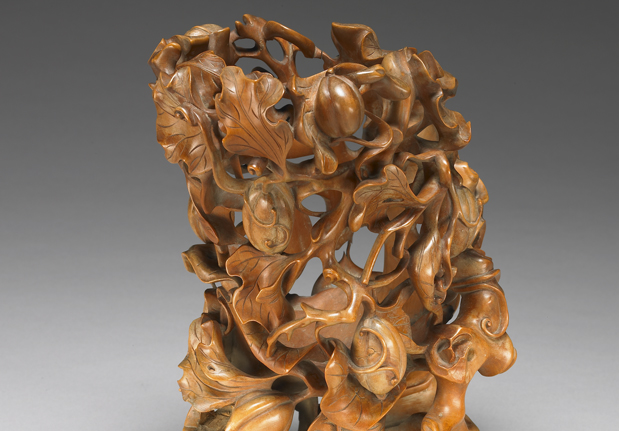Brush-holder with openwork melon-and-vine decor.18th century, Qing dynasty
- Image Number: K1G000018N000000000PAC
- Dynasty: Qing dynasty
- Category: Carvings
- Function: Stationery
- Material: Plants/wood/boxwood
- Description:
Two pieces of boxwood are selected for the whole device, one is thick, and the other is in the shape of a long column. The former gouges out the middle chamber, and then uses the high hollowing carving technique to carve out the winding vines as the main body of the pen pot. Then, using the same techniques and patterns, the long columnar boxwood carvings are decorated with side trunks to be sleeved on the main body, making the whole device complex, hollow everywhere, and the big and small melons are scattered. Although it is a pen container, it is more ornamental than practical. The boxwood is dense in texture and elegant in color, but it is not easy to grow. It usually has no big wood, and is mostly used as the inlay of large carvings such as furniture and architecture. Since the late Ming Dynasty, in view of its texture and color characteristics, it has been selected as one of the materials used for writing room appliances, especially the large pen container, which shows the preciousness of its materials. “The Book of Songs, Daya, Mian”: “Mian Mian Gua, the cradle of the people, comes from the soil.” It is used to describe the prosperity and long history of descendants. Chui, a small melon. The ornamentation of vines entwined with the whole vessel and luxuriant melons and melons symbolizes the Book of Songs; The tedious hollow carving shows the extraordinary skill of the royal craftsman.

![图片[2]-Brush-holder with openwork melon-and-vine decor.18th century, Qing dynasty-China Archive](https://chinaarchive.net/Qing dynasty/Carvings/K1G000018N000000000PAC-61751.jpg)
![图片[3]-Brush-holder with openwork melon-and-vine decor.18th century, Qing dynasty-China Archive](https://chinaarchive.net/Qing dynasty/Carvings/K1G000018N000000000PAC-61752.jpg)
Pictures & Images [HD] download
© Copyright
The copyright of the article belongs to the author, please keep the original link for reprinting.
THE END


![[Qing Dynasty] British female painter—Elizabeth Keith, using woodblock prints to record China from the late Qing Dynasty to the early Republic of China—1915-China Archive](https://chinaarchive.net/wp-content/uploads/2022/11/image-191x300.png)


